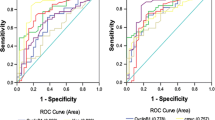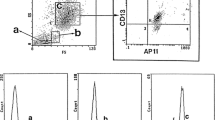Summary
A mouse monoclonal antibody (BA-Br-3) raised against the breast carcinoma cell line CAMA-1 was previously shown to react with a ⩾ 300-kDa globule-like glycoprotein from human milk fat also expressed in the cytoplasm and on the surface of human carcinoma cells of different histological types. In this report the reactivity of this mAb with a large number of normal and malignant human tissues was analyzed using immunoperoxidase techniques. When tested on sections of both fresh-frozen tissues and formalin-fixed, paraffin-embedded tissues, BA-Br-3 reacted with a formalin-resistant antigenic determinant expressed by normal and malignant epithelial cells. Preferential reactivity was observed at the apical portion of ductal epithelial cells in normal breast and in glandular epithelia distributed in several other organs. Reactivity with mucin-like secretions in the lumina of ducts was also found. BA-Br-3 reacted mostly in heterogenous staining patterns with 88% of 49 breast carcinoma specimens tested, regardless of their histological type or whether they were primary or secondary neoplasms. Testing of epithelial malignant tumors other than breast carcinomas with this antibody showed that 127 of 151 (84%) were also reactive. mAb BA-Br-3 and E29 (a commercially available anti-(epithelial membrane antigen) shared very similar staining patterns and distributions of reactivity with breast and other epithelial tumors. However, BA-Br-3 showed a significantly higher percentage of reactivity with melanoma (33% versus 6%,P = 0.003) and a trend toward a higher percentage of reactivity with sarcoma (55% versus 27%,P >0.05). This antibody, therefore, defines a molecule that is a member of the mucin-like epithelial membrane antigen family. Further studies are warranted to determine its usefulness in antibody-directed cancer diagnosis, prognosis, and immunotherapy.
Similar content being viewed by others
References
Abe M, Kufe D (1984) Sodium butyrate induction of milk-related antigens in human MCF-7 breast carcinoma cells. Cancer Res 44: 4574–4577
Arklie J, Taylor-Papdimitriou J, Bodmer W, Egan M, Millis R (1981) Differentiation antigens expressed by epithelial cells in the lactating breast are also detectable in breast cancers. Int J Cancer 28: 23–29
Ashall F, Bramwell M, Harris H (1982) A new marker for human cancer cells. I. The CA antigen and the CA1 antibody. Lancet 2: 1–11
Baildam AD, Howell A, Barnes DM, Turnbull L, Sellwood RA (1989) The expression of milk fat globule antigens within human mammary tumours: relationship to steroid hormone receptors and response to endocrine treatment. Eur J Cancer Clin Oncol 25: 459–467
Barnd D, Finn O (1989) Specific recognition of pancreatic tumor-associated mucin by human MHC-unrestricted cytotoxic T cells. FASEB J 3: A508
Burchell J, Durbin H, Taylor-Papdimitriou J (1983) Complexity of expression of antigenic determinants recognized by monoclonal antibodies HMFG-1 and HMFG-2 in normal and malignant human epithelial cells. J Immunol 135: 508–513
Ceriani R, Peterson J, Lee J, Moncade R, Blank E (1983) Characterization of cell surface antigens of human mammary epithelial cells with monoclonal antibodies prepared against human milk fat globule. Somatic Cell Genet 9: 415–427
Cordell J, Richardson TC, Pulford KAF, Ghosh AK, Gatter KC, Heyderman E, Mason DY (1985) Production of monoclonal antibodies against human epithelial membrane antigen for use in diagnostic immunohistochemistry. Br J Cancer 52: 347–354
Croghan G, Papsidero L, Valenzula L, Nemoto T, Penetrante R, Chu T (1983) Tissue distribution of an epithelial tumor-associated antigen recognized by monoclonal antibody F36/22. Cancer Res 43: 4980–4988
Edwards PAW (1985) Heterogeneous expression of cell-surface antigens in normal epithelia and their tumours, revealed by monoclonal antibodies. Br J Cancer 51: 149–160
Ellis I, Hinton C, MacNay J, Elston C, Robins A, Ovainati A, Blamey R, Baldwin R, Ferry B (1985) Immunocytochemical staining of breast carcinoma with the monoclonal antibody NCRC11: a new prognostic indicator. Br Med J 290: 881–883
Epenetos A, Mather S, Granowska M, Nimmon C, Hawkins L, Britton K, Shepherd J, Taylor-Papdrimitriou J, Durbin H, Malpas J, Bodmer W (1982) Targeting of iodine-123-labelled tumour-associated monoclonal antibodies to ovarian, breast, and gastrointestinal tumours. Lancet 2: 999–1004
Epenetos A, Taylor-Papdimitriou J, Curling M, Canti G, Bodmer W (1982) Use of the two epithelium-specific monoclonal antibodies for diagnosis of malignancy in serous effusions. Lancet 2: 1004–1006
Finn O, Barnd DL, Kerr LA, Micels, Metzgar RS (1989) Specific recognition of human tumor-associated antigen by non-MHC restricted CTL. In: Metzgar RS, Mitchell MS (eds) Human tumor antigens and specific tumor therapy. Alan R. Liss, New York, pp 157–166
Fogh J, Trempe G (1975) New human tumor cell lines. In: Fogh J (ed.) Human tumor cells in vitro. Plenum Press, New York, pp 115–160
Foster C, Dinsdale E, Edwards P, Neville A (1982) Monoclonal antibodies to the human mammary gland. II. Distribution of determinants in breast carcinomas. Virchows Arch 394: 295–305
Hay FG, Leonard RCF (1988) Expression of human milk fat globule antigens HMFG1 and HMFG2 on ovarian tumours and lung tumours. Dis Markers 6: 29–39
Heyderman E, Strudley I, Powell G, Richardson TC, Cordell JL, Mason DY (1985) A new monoclonal antibody to epithelial membrane antigen (EMA)-E29. A comparison of its immunocytochemical reactivity with polyclonal anti-EMA antibodies and with another monoclonal antibody, HMFG-2. Br J Cancer 52: 355–361
Hilgers J, Zotter S (1989) Polymorphic epithelial mucin and CA125-bearing glycoproteins as tumor-associated antigens. Cancer Rev 11/12 1–8
Hilkens J, Hilgers J, Buijis F, Hageman P, Schol D, Van Doornewaard G, Van Den Tweel J (1984) Monoclonal antibodies against human milk fat globule membranes useful in carcinoma research. Protides Biol Fluids 31: 1013–1016
Hsu SM, Raine L, Fanger H (1981) The use of avidin-biotin-peroxidase complex (ABC). Immunoperoxidase technique — a comparison between ABC and unlabeled antibody technique. J Histochem Cytochem 29: 577–580
Horan Hand P, Colcher D, Salomon D, Ridge I, Noguchi P, Schlom J (1985) Influence of spatial configuration of carcinoma cell populations on the expression of a tumor-associated glycoprotein. Cancer Res 45: 833–840
Horan Hand P, Nuti M, Colcher D, Schlom J (1985) Definition of antigenic heterogeneity and modulation among human mammary carcinoma cell populations using monoclonal antibodies to tumor-associated antigens. Cancer Res 43: 728–735
Kufe D, Inghinami G, Abe M, Hayes D, Justin-Wheeler H, Schlom J (1984) Differentiation reactivity of a novel monoclonal antibody (DF3) with human malignant versus benign breast tumors. Hybridoma 3: 223–232
Leong BS, Qureshi S, Leung JS (1982) Response to estrogen by the human mammary carcinoma cell line CAMA-1. Cancer Res 42: 5060–5066
Lewko WM, Ladd P, Hubbard D, He Y-J, Vaghmar R, Husseini S, Chang L, Moore M, Thurman GB, Oldham RK (1989) Tumor acquisition, propagation and preservation: culture of human colorectal cancer. Cancer 64: 1600–1608
Liao S-K, Avner BP, Meranda C, Kanamaru T (1987) Monoclonal antibody BTMA8 with apparent selective specificity for adenocarcinomas of breast, colorectal, and pancreas. Proc Am Assoc Cancer Res 28: 362
Liao S-K, Khosravi MJ, Brown JP, Kwong PC (1987) Difference in cell binding patterns of two monoclonal antibodies recognizing distinct epitopes on a human melanoma-associated oncofetal antigen. Mol Immunol 24: 1–9
Liao S-K, Kwong PC, Clarke BJ, Dent PB, Ryan ED, Khosravi MJ, Leferte S, Krantz MJ (1985) Monoclonal antibody recognizing human melanoma-carcinoma cross-reacting oncofetal antigen epitopically associated with carcinoembryonic antigen. J Natl Cancer Inst 74: 1047–1058
Liao S-K, Meranda C, Avner BP, Romano T, Husseini S, Kimbro B, Oldham RK (1989) Immunohistochemical phenotyping of human solid tumors with monoclonal antibodies in devising biotherapeutic strategies. Cancer Immunol Immunother 28: 77–86
McIlhinney RAJ, Patel S, Gore ME (1985) Monoclonal antibodies recognizing epitopes carried on both glycolipids and glycoproteins of the human milk fat globule membrane. Biochem J 227: 155–162
Manivel JC, Wick MR, Swanson PE, Scheithauer B (1987) Epithelial membrane antigen in sarcoma. Lab Invest 56: 46A
Neville AM, Monaghan P, McIlhinney RAJ, Gusterson B, Coombes RC (1986) Monoclonal antibodies in the detection and treatment of breast cancer micrometastases. In: Zenoglio-Presier CM, Weinstein RS, Kaufman N (eds) New concepts in neoplasia as applied to diagnostic pathology. International Academy of Pathology monographs in pathology no. 27. Williams & Wilkins, Baltimore, pp 193–205
Ogden JR, Leung K (1988) Purification of IgG monoclonal antibodies by caprylic acid. J Immunol Methods 111: 283–284
Oldham RK, Lewis M, Orr DW, Avner BP, Liao S-K, Ogden JR, Avner B, Birch R (1989) Adriamycin custom tailored immunoconjugates in treatment of human malignancies. Mol Biother 1: 104–114
Ormerod M, McIlhinny J, Steel K, Shimizu M (1985) Glycoprotein PAS-O from the milk fat globule membrane carries antigenic determinants for epithelial membrane antigens. Mol Immunol 22: 265–269
Pinkus GS, Kurtin PJ (1985) Epithelial membrane antigen — a diagnostic discriminant in surgical pathology: immunohistochemical profile in epithelial, mesenchymal, and hematopoietic neoplasms using paraffin sections and monoclonal antibodies. Hum Pathol 16: 929–940
Rainsbury R, Westwood J, Coombes R, Neville A, Offe R, Kalirari T, McCready V, Gazet J-C (1983) Location of metastatic breast carcinoma by a monoclonal antibody chelate labelled with indium-111. Lancet 2: 934–938
Rasmussen BB, Hilgers J, Hilkens J (1984) The influence of formalin and paraffin embedding on the immunohistochemical reaction of monoclonal antibodies applied to female breast tissue. Acta Pathol Microbiol Immunol Scand [A] 92: 167–175
Rasmussen B, Pederson B, Thorpe S, Hilkens J, Hilgers J, Rose C (1985) Prognostic value of surface antigens in primary breast carcinomas, detected by monoclonal antibodies. Cancer Res 45: 1424–1427
Russo C, Callegaro L, Lanza E, Ferrone S (1983) Purification of IgG monoclonal antibodies by caprylic acid precipitation. J Immunol Methods 65: 269–271
Swanson PE (1988) Monoclonal antibodies to human milk fat globule proteins. In: Wick MR, Siegal GP (eds) Monoclonal antibodies in diagnostic immunohistochemistry. Marcel Dekker: New York, Basel, pp 227–283
Thor A, Ohuchi N, Szpak CA, Johnson WW, Schlom J (1986) Distribution of oncofetal antigen tumor-associated glycoprotein-72 defined by monoclonal antibody B72.3. Cancer Res 46: 3118–3124
Wells CA, Heryet A, Brochier J, Gatter KC, Mason DY (1984) The immunocytochemical detection of axillary micrometastases in breast cancer. Br J Cancer 50: 193–197
Wilkinson M, Howell A, Harris M, Taylor-Papdimitriou J, Swindell R, Sellwood R (1984) The prognostic significance of two epithelial membrane antigens expressed by human mammary carcinomas. Int J Cancer 33: 299–304
Williams CJ, Major PP, Dion AS (1989) Epithelial membrane antigen (EMA) expression is increased in a mucin-secreting breast tumor cell line (BT 549) by hydrocortisone and insulin supplementation. Proc Am Assoc Cancer Res 30: 356
Yuan D, Handler F, Vitetta E (1982) Characterization of a monoclonal antibody reactive with a subset of human breast tumors. J Natl Cancer Inst 68: 719–728
Zotter S, Lossnitzer A, Kunze KD, Muller M, Hilkens J, Hilgers J, Hageman P (1985) Epithelial markers for paraffin-embedded human tissues. Immunohistochemistry with monoclonal antibodies against milk fat globule antigens. Virchows Arch [A] 406: 237–251
Author information
Authors and Affiliations
Rights and permissions
About this article
Cite this article
Liao, SK., Flahart, R.E., Kimbro, B. et al. Human tumor and normal tissue reactivity of the anti-(breast cancer) monoclonal antibody BA-Br-3 and its similarity to the anti-(epithelial membrane antigen) monoclonal antibody E29. Cancer Immunol Immunother 31, 65–75 (1990). https://doi.org/10.1007/BF01742368
Received:
Accepted:
Issue Date:
DOI: https://doi.org/10.1007/BF01742368




